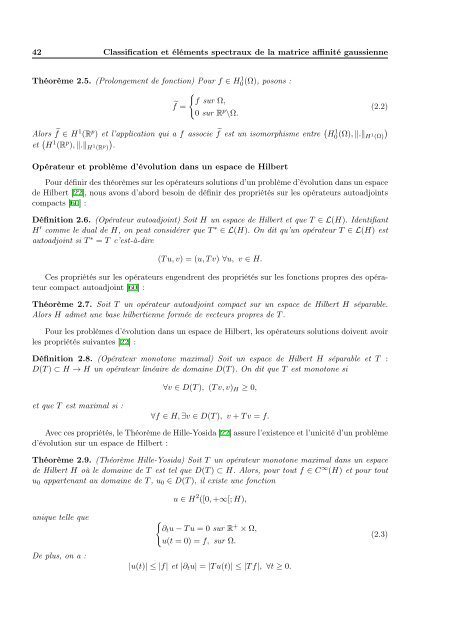Contributions à l'étude de la classification spectrale et applications
Contributions à l'étude de la classification spectrale et applications
Contributions à l'étude de la classification spectrale et applications
Create successful ePaper yourself
Turn your PDF publications into a flip-book with our unique Google optimized e-Paper software.
42 C<strong>la</strong>ssification <strong>et</strong> éléments spectraux <strong>de</strong> <strong>la</strong> matrice affinité gaussienne<br />
Théorème 2.5. (Prolongement <strong>de</strong> fonction) Pour f ∈ H 1 0<br />
f =<br />
<br />
f sur Ω,<br />
0 sur R p \Ω.<br />
(Ω), posons :<br />
Alors f ∈ H1 (Rp ) <strong>et</strong> l’application qui a f associe f est un isomorphisme entre H1 0 (Ω), .H1 <br />
(Ω)<br />
<strong>et</strong> H1 (Rp <br />
), .H1 (Rp ) .<br />
Opérateur <strong>et</strong> problème d’évolution dans un espace <strong>de</strong> Hilbert<br />
Pour définir <strong>de</strong>s théorèmes sur les opérateurs solutions d’un problème d’évolution dans un espace<br />
<strong>de</strong> Hilbert [22], nous avons d’abord besoin <strong>de</strong> définir <strong>de</strong>s propriétés sur les opérateurs autoadjoints<br />
compacts [60] :<br />
Définition 2.6. (Opérateur autoadjoint) Soit H un espace <strong>de</strong> Hilbert <strong>et</strong> que T ∈ L(H). I<strong>de</strong>ntifiant<br />
H ′ comme le dual <strong>de</strong> H, on peut considérer que T ∗ ∈ L(H). On dit qu’un opérateur T ∈ L(H) est<br />
autoadjoint si T ∗ = T c’est-<strong>à</strong>-dire<br />
(T u, v) = (u, T v) ∀u, v ∈ H.<br />
Ces propriétés sur les opérateurs engendrent <strong>de</strong>s propriétés sur les fonctions propres <strong>de</strong>s opérateur<br />
compact autoadjoint [60] :<br />
Théorème 2.7. Soit T un opérateur autoadjoint compact sur un espace <strong>de</strong> Hilbert H séparable.<br />
Alors H adm<strong>et</strong> une base hilbertienne formée <strong>de</strong> vecteurs propres <strong>de</strong> T .<br />
Pour les problèmes d’évolution dans un espace <strong>de</strong> Hilbert, les opérateurs solutions doivent avoir<br />
les propriétés suivantes [22] :<br />
Définition 2.8. (Opérateur monotone maximal) Soit un espace <strong>de</strong> Hilbert H séparable <strong>et</strong> T :<br />
D(T ) ⊂ H → H un opérateur linéaire <strong>de</strong> domaine D(T ). On dit que T est monotone si<br />
<strong>et</strong> que T est maximal si :<br />
∀v ∈ D(T ), (T v, v)H ≥ 0,<br />
∀f ∈ H, ∃v ∈ D(T ), v + T v = f.<br />
Avec ces propriétés, le Théorème <strong>de</strong> Hille-Yosida [22] assure l’existence <strong>et</strong> l’unicité d’un problème<br />
d’évolution sur un espace <strong>de</strong> Hilbert :<br />
Théorème 2.9. (Théorème Hille-Yosida) Soit T un opérateur monotone maximal dans un espace<br />
<strong>de</strong> Hilbert H où le domaine <strong>de</strong> T est tel que D(T ) ⊂ H. Alors, pour tout f ∈ C ∞ (H) <strong>et</strong> pour tout<br />
u0 appartenant au domaine <strong>de</strong> T , u0 ∈ D(T ), il existe une fonction<br />
u ∈ H 2 ([0, +∞[; H),<br />
unique telle que <br />
∂tu − T u = 0 sur R + × Ω,<br />
De plus, on a :<br />
u(t = 0) = f, sur Ω.<br />
|u(t)| ≤ |f| <strong>et</strong> |∂tu| = |T u(t)| ≤ |T f|, ∀t ≥ 0.<br />
(2.2)<br />
(2.3)

















